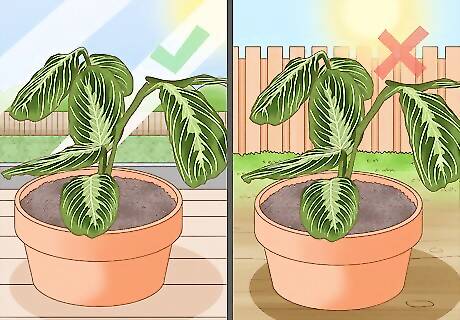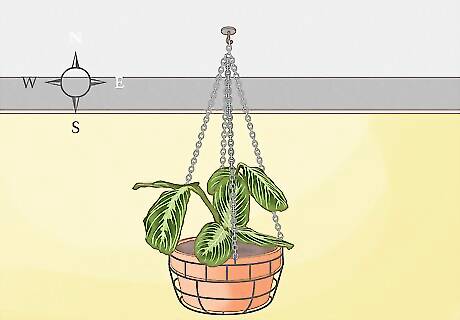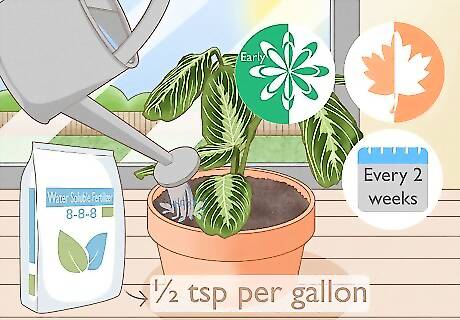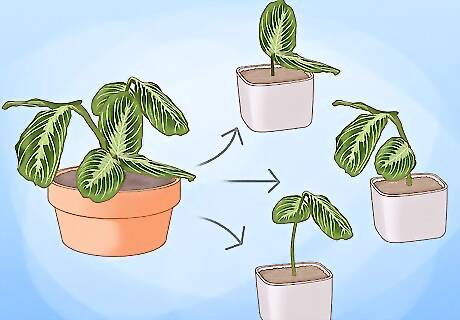
views
Creating the Right Environment for Your Prayer Plant

Put your plant in a shallow container that has drain holes in the bottom. Prayer plants are shallow-rooted plants. So, if they are planted in a deep container with too much soil below its roots, the soil stays soggy for too long and they will develop root rot. If you are potting your plant, always use a container with drain holes so the water can drain from the roots and the soil.

Place your plant in indirect sunlight. You can hang or set your prayer plant near a window where it will get indirect sunlight. Never set your plant in direct sunlight as the sun will bleach the plant's leaves. Less direct sunlight. "My leaves are not rich, dark green and red, and have very little purple underneath. I have moved my plant to a spot with less direct sunlight and put the plant in a shallower pot, both of which helped immensely!" - Ty F. Enhance growth through trimming. "Learning how to trim properly to enhance growth has a huge helper. I also learned to keep the prayer plant in a shallow planter. I hope to find more new growth than I've seen in the two years I've had her." - JamieLee H. We want to hear from you! Advice from our readers makes our articles better. If you have a story you’d like to share, tell us here.

Hang your plant from the ceiling in a west or south facing room. Find a corner where direct light cannot reach the plant and hang it so it gets proper light exposure and grows properly. Proper light exposure results in a prayer plant with rich, green stems and colorful leaves. If your plant does not get enough light, the stems will grow long and spindly as they will naturally reach for more light.

Keep the room temperature between 65 and 75 degrees Fahrenheit and a little humid. As prayer plants are tropical plants, they do not thrive when temperatures dip too far below 70 °F (21 °C). Colder temperatures and dry air will cause the prayer plant's leaves to shrivel and turn brown. Temperatures hotter than 75 °F (24 °C) can result in fewer leaves and long, spindly stems. Increase the humidity in the room with a humidifier or set a pan or dish filled with pebbles and water below the plant to increase the room's humidity. Do not put the prayer plant near heating or cooling vents or doorways where it will be exposed to extreme temperature fluctuations and drafts.
Maintaining Your Prayer Plant

Water the prayer plant when the top of the potting soil is just starting to get dry. The soil should never be allowed to dry out completely. Not enough water and overwatering can cause the leaves to turn yellow and drop from the plant. If the leaves begin to turn yellow, water the plant less often if the soil is still wet or more often if the soil appears dry between waterings. EXPERT TIP Chai Saechao Chai Saechao Plant Specialist Chai Saechao is the Founder and Owner of Plant Therapy, an indoor-plant store founded in 2018 based in San Francisco, California. As a self-described plant doctor, he believes in the therapeutic power of plants, hoping to keep sharing his love of plants with anyone willing to listen and learn. Chai Saechao Chai Saechao Plant Specialist Prayer plants, like maranta, need a lot of humidity. It can be difficult to care for prayer plants, but if you keep the soil moist at all times, they will do better. Some prayer plants are known to close and open up at night and move around.

Use room-temperature water on the plant in the morning. This way, any water splashed on the leaves will be dry before evening. Cold tap water will chill your plant's roots and stress your plants, causing it to drop its leaves. Wet leaves and cooler nighttime temperatures also provide a breeding ground for leaf spot. If your plant develops brown or black spots on its leaves, snip the damaged leaves off at the base and throw them away.

Fertilize your prayer plant every two weeks from early spring through to the fall. Use water-soluble houseplant fertilizer diluted to half-strength. The half-strength dilution rate for most water-soluble fertilizers is about ½ teaspoon per gallon of water but it could be slightly higher or lower. Check the label for the manufacturer's recommended dilution rate and reduce the amount by half. Aim for a balanced houseplant fertilizer with a ratio of 8-8-8 or 10-10-10. Too little fertilizer will cause the prayer plant to grow slowly or not at all. Too much fertilizer will burn the roots and cause the leaves to develop dry brown edges. When given the correct amount of fertilizer, prayer plants will have healthy green stems and leaves and grow vigorously.

Make your own potting mix for your plant. Use a peat-based potting mix with a pH of 5.5 to 6.0 or mix two parts sphagnum peat moss, one part loamy soil, and one part perlite or coarse sand together. Stir all of the ingredients together until they are thoroughly mixed. Sphagnum peat moss, loamy soil, perlite, and coarse sand can be purchased at local garden centers. Purchase only clean, pre-packaged materials that have been commercially processed and are free of insects and weed seeds.

Only repot the prayer plant in the spring or summer if it becomes pot-bound. When the container for the plant becomes full of roots, the potting mix dries out very quickly, causing the prayer plant to grow very slowly. This condition is called pot-bound. The new container for your plant should be only 1 to 2 inches wider than the old one. Put 1 inch of potting mix in the bottom of the new container, remove the prayer plant from the old container, place it in the new container and finish filling it with the potting mix. Once it's been repotted, water it generously to settle the soil around the roots.

Divide the plant into smaller plants once it has been repotted. You can divide your prayer plant into several smaller plants by gently shaking the soil off the roots and working them apart. Each new plant should have a good mass of roots and several stems. Pot these new smaller plants up separately in small, shallow pots.

Trim your plants two to three times a year to help them grow more vigorously. Use sharp scissors or hand pruners to snip a few of the stems back by a few inches. Make the cuts just above a leaf. New stems and leaves will grow from the growth nodes located below the cut where the remaining leaf is growing, so you will have lots of prayer plants to enjoy in your home.




















Comments
0 comment